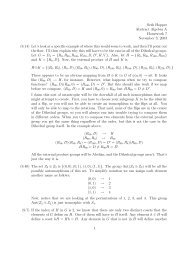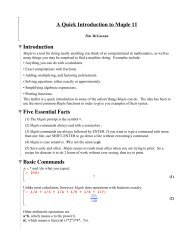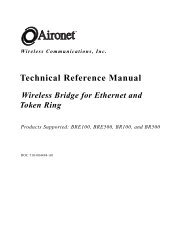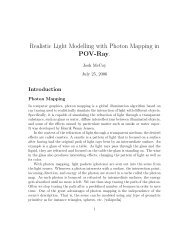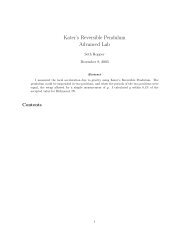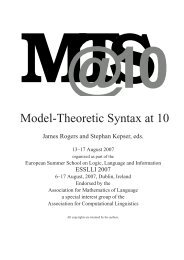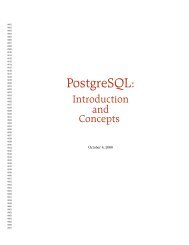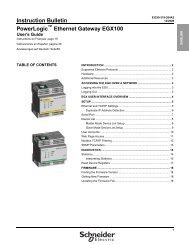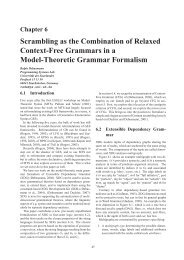The Use of Formal Language Theory in Studies of Artificial - CiteSeerX
The Use of Formal Language Theory in Studies of Artificial - CiteSeerX
The Use of Formal Language Theory in Studies of Artificial - CiteSeerX
Create successful ePaper yourself
Turn your PDF publications into a flip-book with our unique Google optimized e-Paper software.
4.1 Strictly Local Str<strong>in</strong>gsets<strong>The</strong> simplest def<strong>in</strong>itions we will explore are those that specify str<strong>in</strong>gs solely<strong>in</strong> terms <strong>of</strong> the sequences <strong>of</strong> symbols that are permitted to occur adjacently <strong>in</strong>them, that is, <strong>in</strong> terms <strong>of</strong> the n-grams mak<strong>in</strong>g up the str<strong>in</strong>g. S<strong>in</strong>ce our n-gramsare not associated with probabilities we will refer to them with the standardFLT term<strong>in</strong>ology: k-factors.A k-factor is just a length k sequence <strong>of</strong> symbols. A Strictly k-LocalDef<strong>in</strong>ition is a set <strong>of</strong> k-factors drawn from some f<strong>in</strong>ite alphabet <strong>of</strong> symbolsaugmented with beg<strong>in</strong>n<strong>in</strong>g <strong>of</strong> str<strong>in</strong>g (⋊) and end <strong>of</strong> str<strong>in</strong>g (⋉) markers. Astr<strong>in</strong>g w satisfies a strictly k-local def<strong>in</strong>ition if and only if (iff ) the set <strong>of</strong>k-factors <strong>of</strong> the augmented str<strong>in</strong>g ⋊w⋉ is a subset <strong>of</strong> those <strong>in</strong>cluded <strong>in</strong> thedef<strong>in</strong>ition. A str<strong>in</strong>gset is <strong>in</strong> the class SL k iff it can be def<strong>in</strong>ed with a strictlyk-local def<strong>in</strong>ition, it is Strictly Local (SL) (McNaughton and Papert 1971) iffit is SL k for some k.<strong>The</strong> set <strong>of</strong> str<strong>in</strong>gs <strong>of</strong> the form (AB) n is an example <strong>of</strong> an SL 2 str<strong>in</strong>gset,be<strong>in</strong>g def<strong>in</strong>able by the (m<strong>in</strong>imal) set <strong>of</strong> 2-factors:(2) D (AB) ndef= {⋊A, AB, BA, B⋉},which asserts that the str<strong>in</strong>g must beg<strong>in</strong> with an A, end with a B, that everyA is followed by a B and that every B other than the last is followed byan A. <strong>The</strong> set <strong>of</strong> str<strong>in</strong>gs licensed by this def<strong>in</strong>ition, denoted L(D (AB) n), is{(AB) i | i > 0}.Membership <strong>in</strong> a Strictly Local str<strong>in</strong>gset depends only on the k-factors <strong>in</strong>isolation: a str<strong>in</strong>g satisfies an SL k def<strong>in</strong>ition iff each <strong>of</strong> the k-factors <strong>in</strong> thestr<strong>in</strong>g is <strong>in</strong>dependently licensed by that def<strong>in</strong>ition. From a cognitive perspective,all that is required to recognize a strictly k-local str<strong>in</strong>gset is attention toeach block <strong>of</strong> k symbols which occurs <strong>in</strong> the str<strong>in</strong>g. If the str<strong>in</strong>g is presentedsequentially <strong>in</strong> time, this amounts to remember<strong>in</strong>g just the last k consecutiveevents that have been encountered.<strong>The</strong> key to reason<strong>in</strong>g about the structure <strong>of</strong> SL str<strong>in</strong>gsets <strong>in</strong> general isa theorem which characterizes them <strong>in</strong> terms <strong>of</strong> a property known as suffixsubstitution closure: a str<strong>in</strong>gset is SL iff there is some k for which it is closedunder the substitution <strong>of</strong> suffixes that beg<strong>in</strong> with the same (k − 1)-factor.This allows us to identify non-SL str<strong>in</strong>gsets and to construct m<strong>in</strong>imalpairs <strong>of</strong> str<strong>in</strong>gsets which can be diagnostic <strong>of</strong> the ability to generalize SLpatterns. One simple non-SL str<strong>in</strong>gset is the set <strong>of</strong> str<strong>in</strong>gs <strong>of</strong> As and Bs <strong>in</strong>9



